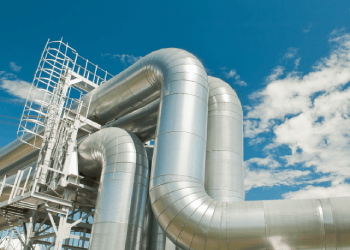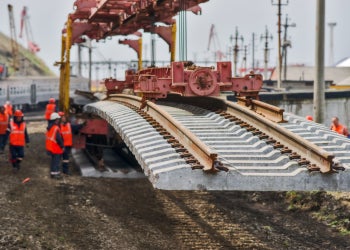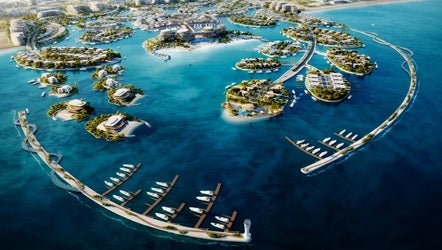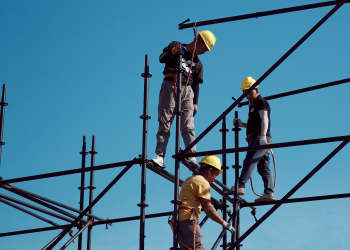UAE food producers struggle with global challenges
29 November 2022
Local food and beverage (F&B) producers in the UAE say the sector is being severely constrained by rising input costs and unprecedented challenges caused by the Russia-Ukraine conflict.
The impact of the war, which began in February this year, has reverberated across the globe, creating uncertainty and insecurity in global food supply chains.
The food industry is among the vital focus industrial sectors of the UAE’s Ministry of Industry & Advanced Technology’s (MoIAT) Operation 300bn plan, not only to enhance its contribution to GDP but also to support long-term food security and self-sufficiency by facilitating local production.
 Food security strategy
Food security strategy
For industry stakeholders gathered at the MEED-Mashreq Manufacturing Business Leaders Forum, the Covid-19 crisis and conflict in Ukraine have only further underlined the importance of pursuing a food security strategy.
“The UAE F&B industry has more than 550 manufacturing units and employs more than 80,000 workers with a value of production of over AED35bn and exports of more than AED15bn,” said Ahmed Bayoumi, CEO of Global Food Industries (GFI) and board member of the UAE Food & Beverage Manufacturers Group.
“The Ministry of Climate Change and the Ministry of Industry are jointly spearheading efforts to increase the domestic supply of food products and to make the UAE one of the most food-secure countries in the world,” explained Bayoumi.
“The two strategies, food security and Operation 300bn, both have many programmes to support the industry. We also really appreciate the new free trade agreements and the building of new trade routes with India, Indonesia and Israel.”
Import dependence
The UAE and other Gulf nations – considered food-secure due to their economic and political stability – have not faced food shortages since the pandemic outbreak. But food security and limiting vulnerability to import disruptions remains a key strategic long-term goal for the UAE government, as it lacks control over its sources.
GCC countries, including the UAE, typically import nearly 85 per cent of their food.
Compounding the situation is the harsh climate, with the expansion of local food production limited due to the scarcity of natural resources such as water and arable land.
According to the World Resources Institute, the Middle East and North Africa is the most water-stressed region globally, with the World Bank forecasting that the region will experience the highest economic losses from climate-related water scarcity compared with other global regions, at about six to 14 per cent of their GDP by 2050.
Conflict stress
Closed-off access to the lower-priced Black Sea grain since the outbreak of the war has induced commodity shortages and exacerbated inflationary pressures for purchasers already struggling with still fragile pandemic-disrupted supply chains, high import costs and spikes in energy costs.
“Because of the Ukraine war, sunflower oil and flour prices are up by almost 60 per cent,” a local food manufacturer said during the forum.
“Additionally, the Indian government has banned wheat exports from India. This has created an increase in commodity prices in the local market. It directly impacts me because almost all my products use wheat. Wheat flour is 60 per cent of my raw material.”
The challenge, he said, is further compounded because commodity suppliers have been demanding advance payments as they capitalise on the shortages.
But in the credit-driven UAE market, manufacturers are still bound by 90 to 120-day payment cycles.
“At the same time, I am restricted from increasing my prices,” the manufacturer said. “It is not healthy for the industry. There must be some intervention from the ministry to address this.”
Almost 99 per cent of food products in the UAE are no longer regulated in terms of pricing. This is due to the dialogue between the Ministry of Economy and the industry – credit where credit is due
Ahmed Bayoumi, Global Food Industries
Countering inflation
Inflation has risen to historic levels in many markets worldwide, significantly impacting consumers and businesses.
In the UAE, the IMF forecasted that inflation will be at 5.2 per cent this year.
One local manufacturer at the forum said businesses have “no other way” to protect their finances and margins than to raise the prices of their goods.
“The government does not like to disturb consumers with price increases, but this is a very big challenge for manufacturers,” he said. “If manufacturers don’t increase prices, they will lose money.”
A 2022 Grant Thornton survey of 5,000 mid-market businesses across 28 countries, including the UAE, revealed that 87 per cent of businesses in the UAE have opted to pass the cost of surging inflation to consumers in a bid to protect their margins by increasing their prices, “at the same level or above our cost increases”.
According to the study, businesses have seen increases of 18 per cent in their energy and utility bills, 17 per cent in raw materials costs and 14 per cent in salaries or staff compensation. Businesses also saw a 16 per cent increase in outgoings related to equipment, as well as bank, interest and taxes.
The UAE government typically caps prices of staple food items to keep inflation in check and ensure shopping remains affordable for families. In April 2022, however, the Ministry of Economy said it was monitoring 300 frequently bought essential food items to identify products whose prices could be raised in line with rising import costs, subject to approvals.
“Almost 99 per cent of food products in the UAE are no longer regulated in terms of pricing,” said GFI’s Bayoumi. “This is due to the dialogue between the Ministry of Economy and the industry – credit where credit is due.
“There are only some basic staples that are regulated, and this was a major breakthrough after almost 20 years of everything being regulated.”
Achieving self-sufficiency
The long-term vision of the UAE’s food security strategy is to achieve self-sufficiency, creating an optimum balance between domestic production and securing food production channels overseas.
Ongoing challenges, however, are impacting the speed with which this vision can be achieved.
“Producers who perhaps enjoy more subsidies or, due to currency fluctuations, can access the UAE market at low cost. This tends to come at the cost of demand for local manufacturers,” said Bayoumi.
The strong dollar, meanwhile, has been a “double-edged sword”.
“On the one side, it helps you with your imports from everywhere in the world. So, imports are cheaper in terms of raw materials or equipment. But, on the other hand, in terms of exports, nations using the Euro, for example, are screaming that they can’t buy our product anymore because they have appreciated by 20 per cent.”
“I think the UAE has to think to have some kind of ownership of lands abroad,” a manufacturer at the forum said. “This might open a big door for the UAE. That will secure our raw materials in terms of availability and prices.”
The UAE is already taking steps in this area, with efforts spearheaded by its investment vehicles.
In 2020, Abu Dhabi’s International Holdings Company (IHC) said it would invest over $225m to develop and cultivate over 100,000 acres of farmland in Sudan to help secure high-quality agricultural output.
Earlier this year, Abu Dhabi holding company ADQ bought a majority stake in Cyprus-headquartered agriculture company Unifrutti. The firm produces, trades and distributes more than 100 varieties of fresh produce, and sells 560,000 tonnes of fresh fruit a year. It has 14,000 hectares of farms across four continents and customers in 50 countries.
ADQ previously acquired a 45 per cent stake in French firm Louis Dreyfus, and has stakes in local companies, including fresh produce and agri-tech group Silal; forage and agribusiness group Al-Dhahra Holding; and food and beverage group Agthia.
Equal opportunities
Bayoumi noted that overall, demand within the UAE is recovering “very strongly” after the pandemic.
“Especially with visitor numbers growing, we see market demand growing, and we anticipate that this growth will continue going forward,” he said.
“But also, competition is intensifying. More players are seeing the Gulf as one of the most attractive markets globally over the next three to five years, more players are coming into the market, and more players are vying for a piece of the cake.”
Medium-sized enterprises are at a further disadvantage when compared to regional giants.
“One of the things being discussed and under study is how medium-sized enterprises can be provided with access to centres of excellence that would pool resources in areas such as research and technology, which an individual entity might not be able to afford otherwise. That would make them more competitive over the long term versus the big players,” he said.
“The concentration of retail power also needs to be addressed. In the past, there were thousands of places to sell your product and hardly pay anything. Now two or three major retailers have 50 to 60 per cent of the market. They impose demands and if you do not comply, you could end up delisted or chucked off shelves.”
By Megha Merani
Exclusive from Meed
-
 SLB passes evaluation for Kuwait upstream project
SLB passes evaluation for Kuwait upstream project12 December 2025
-
 Dana Gas makes onshore discovery in Egypt
Dana Gas makes onshore discovery in Egypt12 December 2025
-
 SAR to tender new phosphate rail track section in January
SAR to tender new phosphate rail track section in January12 December 2025
-
 Dar Global to develop $4.2bn Oman mixed-use project
Dar Global to develop $4.2bn Oman mixed-use project10 December 2025
-
 Contract award nears for Saudi Defence Ministry headquarters
Contract award nears for Saudi Defence Ministry headquarters10 December 2025
All of this is only 1% of what MEED.com has to offer
Subscribe now and unlock all the 153,671 articles on MEED.com
- All the latest news, data, and market intelligence across MENA at your fingerprints
- First-hand updates and inside information on projects, clients and competitors that matter to you
- 20 years' archive of information, data, and news for you to access at your convenience
- Strategize to succeed and minimise risks with timely analysis of current and future market trends

Related Articles
-
 SLB passes evaluation for Kuwait upstream project
SLB passes evaluation for Kuwait upstream project12 December 2025
The US-based oilfield services company SLB, formerly Schlumberger, has passed the technical bid evaluation for a major project to develop Kuwait’s Mutriba oil field.
The Houston-headquartered company was the only bidder to pass the technical evaluation for the Mutriba integrated project management (IPM) contract.
The minimum passing technical evaluation score was 75%.
The full list of bidders was:
- SLB (US): 97%
- Halliburton (US): 72%
- Weatherford (US): 61.5%
The decision was finalised at a meeting of the Higher Purchase Committee (HPC) of state-owned Kuwait Petroleum Corporation (KPC) on 20 November 2025.
According to a document published earlier this year by KOC, the IPM tender for the Mutriba field aims to “accelerate production through a comprehensive study that includes economic feasibility evaluation, well planning and long-term sustainability strategies”.
The field was originally discovered in 2009.
Commercial production from the Mutriba field started earlier this year, on 15 June, after several wells were connected to production facilities.
The field is located in a relatively undeveloped area in northwest Kuwait and spans more than 230 square kilometres.
The oil at the Mutriba field has unusually high hydrogen sulfide content, which can be as much as 40%.
This presents operational challenges requiring specialised technologies and safety measures.
In order to start producing oil at the field, KOC deployed multiphase pumps to increase hydrocarbon pressure and enable transportation to the nearest Jurassic production facilities in north Kuwait.
The company also built long-distance pipelines stretching 50 to 70 kilometres, using high-grade corrosion-resistant materials engineered to withstand the high hydrogen sulfide levels and ensure long-term reliability.
KOC also commissioned the Mutriba long-term testing facility in northwest Kuwait, with a nameplate capacity of around 5,000 barrels of oil a day (b/d) and 5 million standard cubic feet of gas a day (mmscf/d).
Once this facility was commissioned, production stabilised at 5,000 b/d and 7 mmscf/d.
In documents published earlier this year, KOC said that starting production from the field had “laid a solid foundation” for the IPM contract by generating essential reservoir and surface data that will guide future development.
Future output from the field is expected to range between 80,000 and 120,000 b/d, in addition to approximately 150 mmscf/d of gas.
https://image.digitalinsightresearch.in/uploads/NewsArticle/15235579/main.png -
 Dana Gas makes onshore discovery in Egypt
Dana Gas makes onshore discovery in Egypt12 December 2025
Register for MEED’s 14-day trial access
UAE-based Dana Gas has made an onshore gas discovery in Egypt’s Nile Delta area, according to a statement from the company.
The discovery was made by the drilling of the North El-Basant 1 exploratory well, and initial well results indicate estimated reserves of 15-25 billion cubic feet of gas.
Production from the reserve is expected to exceed 8 million cubic feet a day (cf/d) once the well is connected to the national network.
The North El-Basant 1 exploratory well was the fourth well in a campaign of 11 development and exploration wells.
The campaign is being executed as part of the company’s $100m investment programme to support domestic gas production, increase reserves and meet growing energy demand.
Earlier this year, Dana Gas completed the drilling of three wells, adding 10 million cf/d.
The programme is expected to increase long-term production and add approximately 80 billion cubic feet of recoverable gas reserves, according to Dana Gas.
Dana Gas expects to start drilling the fifth well in the programme, the Daffodil exploration well, in the first week of January 2026.
Richard Hall, the chief executive of Dana Gas, said: “The latest drilling success reinforces the value of our investment programme in Egypt and highlights the significant remaining potential within the Nile Delta.”
He added: “By increasing local gas production, the programme will help reduce Egypt’s reliance on imported liquefied natural gas (LNG) and fuel oil and is expected to generate more than $1bn in savings for the national economy over time.”
Previously, Dana Gas signed an agreement with state-owned Egyptian Natural Gas Holding Company (EGas) to secure additional acreage under improved fiscal terms, and to accelerate drilling activity.
Hall said: “We appreciate the strong cooperation from EGas and the ministry, and we remain committed to delivering the majority of our planned programme next year.
“Regular and timely payments from our partners are crucial to sustaining our investment programme in Egypt."
In November, a new gas discovery was made in Egypt’s Western Desert region by Khalda Petroleum Company, a joint venture of state-owned Egyptian General Petroleum Corporation and US-headquartered Apache Corporation.
Egypt also started gas production from the West Burullus field in the Mediterranean Sea, after connecting the first wells to the national gas grid.
The country is currently pushing to increase gas production in order to meet domestic demand and reduce its import bill.
https://image.digitalinsightresearch.in/uploads/NewsArticle/15235552/main.png -
 SAR to tender new phosphate rail track section in January
SAR to tender new phosphate rail track section in January12 December 2025

Register for MEED’s 14-day trial access
Saudi Arabian Railways (SAR) is expected to float another multibillion-riyal tender to double the tracks on the existing phosphate railway network connecting the Waad Al-Shamal mines to Ras Al-Khair in the Eastern Province.
MEED understands that the new tender – covering the second section of the track-doubling works, spanning more than 150 kilometres (km) – will be issued in January.
The new tender follows SAR’s issuance of the tender for the project's first phase in November, which spans about 100km from the AZ1/Nariyah Yard to Ras Al-Khair.
The scope includes track doubling, alignment modifications, new utility bridges, culvert widening and hydrological structures, as well as the conversion of the AZ1 siding into a mainline track.
The scope also covers support for signalling and telecommunications systems.
The tender notice was issued in late November, with a bid submission deadline of 20 January 2026.
Switzerland-based engineering firm ARX is the project consultant.
MEED understands that these two packages are the first of four that SAR is expected to tender for the phosphate railway line.
The other packages expected to be tendered shortly include the depot and the systems package.
In 2023, MEED reported that SAR was planning two projects to increase its freight capacity, including an estimated SR4.2bn ($1.1bn) project to install a second track along the North Train Freight Line and construct three new freight yards.
Formerly known as the North-South Railway, the North Train is a 1,550km-long freight line running from the phosphate and bauxite mines in the far north of the kingdom to the Al-Baithah junction. There, it diverges into a line southward to Riyadh and a second line running east to downstream fertiliser production and alumina refining facilities at Ras Al-Khair on the Gulf coast.
Adding a second track and the freight yards will significantly increase the network’s cargo-carrying capacity and facilitate increased industrial production. Project implementation is expected to take four years.
State-owned SAR is also considering increasing the localisation of railway materials and equipment, including the construction of a cement sleeper manufacturing facility.
https://image.digitalinsightresearch.in/uploads/NewsArticle/15229624/main.jpg -
 Dar Global to develop $4.2bn Oman mixed-use project
Dar Global to develop $4.2bn Oman mixed-use project10 December 2025
Register for MEED’s 14-day trial access
Saudi Arabia-headquartered real estate developer Dar Global has announced that it will develop a mixed-use project in Muscat at an estimated investment of RO1.6bn ($4.2bn).
Dar Global will co-develop the Muscat Marine, Art & Digital District project with Oman's Art District Real Estate Development Company.
The project will cover an area of over 1.5 million square metres (sq m) and will be developed in several phases over 12 years.
The development will comprise a mix of residential communities, cultural venues, marinas, retail spaces, finance and business parks and hotels.
Dar Global, a subsidiary of Dar Al-Arkan, was one of the first Saudi brands to list on the London Stock Exchange.
Dar Al-Arkan established Dar Global in 2017 to focus on developing projects in the Middle East and Europe, including in Dubai, Qatar, Oman, London and the Costa del Sol in southern Spain.
Dar Global has $12bn-worth of projects under development in six countries: the UAE, Oman, Qatar, Saudi Arabia, the UK and Spain.
It completed three developments – the Urban Oasis and Da Vinci towers in Dubai and the Sidra gated community in Bosnia – in 2023.
The company collaborates with global brands including Missoni, W Hotels, Versace, Elie Saab, Automobili Pagani and Automobili Lamborghini.
In Oman, Dar Global is also developing the Aida project. In May, it awarded a contract to develop the villas and apartments as part of the project.
According to an official statement, the construction works are expected to start immediately and the project is slated for completion in 2026.
The main contract was awarded to local firm Al-Adrak Trading & Contracting.
The latest announcement follows the awarding of contracts in June last year for the development of the first phase of the Aida project.
The Aida project is being developed as a joint venture with Omran Group and the first phase is expected to be completed in 2027.
UK analytics firm GlobalData forecasts that the Omani construction industry will expand at an annual average growth rate of 4.2% in 2025-28. Growth in the country will be supported by rising government investments in renewable energy, the transport infrastructure and the housing sector, all as part of Oman's Vision 2040 strategy.
Growth during the forecast period will also be supported by increasing hospitality sector investments, with the government planning to invest RO11.9bn ($31bn) in tourism development projects by 2040 and supporting the construction of several hospitality projects.
https://image.digitalinsightresearch.in/uploads/NewsArticle/15222694/main.jpg -
 Contract award nears for Saudi Defence Ministry headquarters
Contract award nears for Saudi Defence Ministry headquarters10 December 2025

Saudi Arabia’s Defence Ministry (MoD) is preparing to award the contract to build a new headquarters building, as part of its P-563 programme in Riyadh.
MEED understands that bid evaluation has reached advanced stages and the contract award is imminent.
The MoD issued the tender in April. The commercial bids were submitted in September, as MEED reported.
Located to the northwest of Riyadh, the P-563 programme includes the development of facilities and infrastructure to support the MoD’s broader initiatives under the kingdom’s Vision 2030 strategy.
It covers the construction of:
- A new military city featuring the MoD headquarters, support and logistics facilities, a residential and commercial community and space for future command centres
- A National Defence University with a library, conference centre and academic buildings
- A self-sustaining Joint Forces Command compound located approximately 50 kilometres from the military city
The budget for the entire programme is expected to be $10bn-$12bn.
In September 2023, MEED reported that Spain-headquartered Typsa had won two contracts for the project.
The first contract, worth $11.4m, included data management, geographic information systems management, geotechnical reporting and the preparation of the phase one final traffic report. The contract duration was 270 days from the notice to proceed.
The second contract, valued at $10.8m, involved preparing four conceptual masterplans for the P-563 site. It was set to last 255 days from the notice to proceed.
These followed a $290m consultancy contract awarded to Typsa in March of the same year. The single-award task order covered a three-year base period, with an optional two-year extension.
Typsa’s scope of work included programme management planning, communications, change and quality management and cost and schedule tracking.
It also included design requirements, codes, standards and submission requirements, programme guidance, study integration, risk analysis and management, design reviews and a programme-of-work breakdown plan.
 READ THE DECEMBER 2025 MEED BUSINESS REVIEW – click here to view PDF
READ THE DECEMBER 2025 MEED BUSINESS REVIEW – click here to view PDFProspects widen as Middle East rail projects are delivered; India’s L&T storms up MEED’s EPC contractor ranking; Manama balances growth with fiscal challenges
Distributed to senior decision-makers in the region and around the world, the December 2025 edition of MEED Business Review includes:
> AGENDA 1: Regional rail construction surges ahead> INDUSTRY REPORT 1: Larsen & Toubro climbs EPC contractor ranking> INDUSTRY REPORT 2: Chinese firms expand oil and gas presence> CONSTRUCTION: Aramco Stadium races towards completion> RENEWABLES: UAE moves ahead with $6bn solar and storage project> INTERVIEW: Engie pivots towards renewables projects> BAHRAIN MARKET FOCUS: Manama pursues reform amid strainTo see previous issues of MEED Business Review, please click herehttps://image.digitalinsightresearch.in/uploads/NewsArticle/15222401/main.gif



